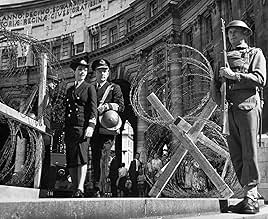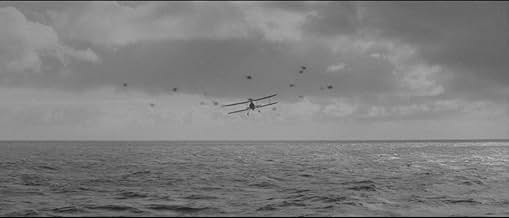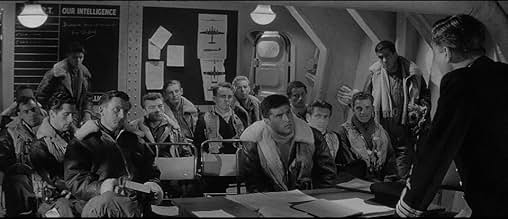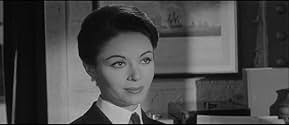AVALIAÇÃO DA IMDb
7,2/10
8,8 mil
SUA AVALIAÇÃO
Adicionar um enredo no seu idiomaThe World War II story of the Royal Navy's effort to defeat Nazi Germany's most powerful warship.The World War II story of the Royal Navy's effort to defeat Nazi Germany's most powerful warship.The World War II story of the Royal Navy's effort to defeat Nazi Germany's most powerful warship.
- Direção
- Roteiristas
- Artistas
- Prêmios
- 2 indicações no total
Carl Möhner
- Kapitän Ernst Lindemann
- (as Carl Mohner)
Jack Gwillim
- Commodore Wilfrid Patterson - HMS King George V
- (as Jack Gwillam)
Avaliações em destaque
The British have made war and historical movies with an unrivaled consistency of quality, and Sink the Bismarck is no exception. The details are meticulous, the casting first-rate (except for a hokey voice-impersonation of Churchill), and the battle sequences marked by accuracy and fine special effects.
This otherwise fine film is marred, however, by the false depiction of one of the major characters, Admiral Lutjens, commander of the Bismarck. In the film, he is stereotyped as the typical Nazi - a Hitler sycophant, careerist and wild-eyed fanatic. This was most certainly not the historical Lutjens, who was by no means a Nazi fanatic. Lutjens was a naval hero from World War I, who served out of duty and dedication, not Nazi conviction. (Lutjens protected Jews under his command, and members of his family were in trouble for their anti-Nazi views.) This is at complete odds with his depiction in Sink the Bismarck, which I find inexcusable, given that the above information was certainly available to the production. In fact, an accurate depiction of Lutjens would have, in my opinion, added interest to the plot.
Nevertheless, Sink the Bismarck is eminently watchable and a fine addition to any war movie collection, if you bear in mind the above caveat.
This otherwise fine film is marred, however, by the false depiction of one of the major characters, Admiral Lutjens, commander of the Bismarck. In the film, he is stereotyped as the typical Nazi - a Hitler sycophant, careerist and wild-eyed fanatic. This was most certainly not the historical Lutjens, who was by no means a Nazi fanatic. Lutjens was a naval hero from World War I, who served out of duty and dedication, not Nazi conviction. (Lutjens protected Jews under his command, and members of his family were in trouble for their anti-Nazi views.) This is at complete odds with his depiction in Sink the Bismarck, which I find inexcusable, given that the above information was certainly available to the production. In fact, an accurate depiction of Lutjens would have, in my opinion, added interest to the plot.
Nevertheless, Sink the Bismarck is eminently watchable and a fine addition to any war movie collection, if you bear in mind the above caveat.
Kenneth More plays the severe cold and uncompromising Captain Jonathan Shepard who has lost his wife in an air raid, and whose son is a naval pilot in the warfare against the Bismarck...
'Bismarck' is a super German battleship of World War II that had a short, but spectacular career...
Captain Shepard guides the distinguished campaign from the Admiralty War headquarters in London: The search, the course, the deploy and the destruction of the Bismarck under an archetype that said: 'Getting emotional about things is a peacetime luxury.'
The Bismarck's admiral (Karel Stepanek) is a Nazi officer characterized by emotional instability, presumptuous and overenthusiastic...
Sighted and bombarded by British battleships, the Bismarck is incapacitated and sunk by torpedoes on the morning of May 27, 1941.
Dana Wynter is the likable attractive lady naval officer, fitting in mood and attitude...
In the climax of the film and after the naval epic, Michael Hordern, the Commander-in-Chief of the Home Fleet, turns to his men and says: 'Let's go home, gentlemen!'
This exciting sea battle would have been better on a standard screen than in CinemaScope, as its ships were clearly 'models' using newsreels footage... Nevertheless, the film is an entertaining hunt, with good acting.
Beside the search and eventual sinking of the Bismarck, I would like to mention, that the personal drama of the British sailors increase the intensity of the picture's realism...
'Bismarck' is a super German battleship of World War II that had a short, but spectacular career...
Captain Shepard guides the distinguished campaign from the Admiralty War headquarters in London: The search, the course, the deploy and the destruction of the Bismarck under an archetype that said: 'Getting emotional about things is a peacetime luxury.'
The Bismarck's admiral (Karel Stepanek) is a Nazi officer characterized by emotional instability, presumptuous and overenthusiastic...
Sighted and bombarded by British battleships, the Bismarck is incapacitated and sunk by torpedoes on the morning of May 27, 1941.
Dana Wynter is the likable attractive lady naval officer, fitting in mood and attitude...
In the climax of the film and after the naval epic, Michael Hordern, the Commander-in-Chief of the Home Fleet, turns to his men and says: 'Let's go home, gentlemen!'
This exciting sea battle would have been better on a standard screen than in CinemaScope, as its ships were clearly 'models' using newsreels footage... Nevertheless, the film is an entertaining hunt, with good acting.
Beside the search and eventual sinking of the Bismarck, I would like to mention, that the personal drama of the British sailors increase the intensity of the picture's realism...
This movie is a well crafted and gripping depiction of British attempts to locate and destroy the German battleship Bismarck during World War II. It is told from the viewpoint of sailors aboard vessels from both sides and also the British naval command headquarters. I have little knowledge of naval history so am in no position to comment regarding historical accuracy.
Personally, I found most compelling the strategy and tension within the Admiralty War Headquarters in London, especially the personal depiction of the coordinator of this operation. Kenneth More convincingly plays Captain Jonathan Shepard, who lost his own wife earlier in an air raid and has a son who is himself a naval pilot involved in the battle to sink the Bismarck. Shepard's relationship with the lovely but very professional female naval officer Davis is well captured. There is also a moving portrait of Shepard's restrained response to unfolding news regarding his son. Though there is engaging battle drama at sea, it's the character portrayal of this stiff upper lip British officer that made the movie for me.
Personally, I found most compelling the strategy and tension within the Admiralty War Headquarters in London, especially the personal depiction of the coordinator of this operation. Kenneth More convincingly plays Captain Jonathan Shepard, who lost his own wife earlier in an air raid and has a son who is himself a naval pilot involved in the battle to sink the Bismarck. Shepard's relationship with the lovely but very professional female naval officer Davis is well captured. There is also a moving portrait of Shepard's restrained response to unfolding news regarding his son. Though there is engaging battle drama at sea, it's the character portrayal of this stiff upper lip British officer that made the movie for me.
Yes, my children, there was a time when movies knew nothing of CGI, and very difficult scenes of violence and destruction were given over to names like Buddy Gillespie, Wally Veevers, and Warren Newcombe, Howard and Teddy Lydecker. These men looked deep inside their childhoods, and started using miniatures, filmed at slow motion camera speeds to proportionately smooth out the movement of model ships, water, model airplanes, collapsing and exploding buildings, even crash model cars.
The most difficult miniature work was with water and the look of the water in relation to a miniature ship.
It was found that the larger the model ship, the more realistic the water looked, and in Columbia's "Sink the Bismarck", the ships were anywhere from 40-60 feet in length. The water body was an indoor pool over 300 ft. in diameter, surrounded by wind machines and under the floor of the tank, large hydraulic pistons created waves.
Can you imagine what fun that was? Blowing up and sinking these huge models.....it was a dream of mine for years.
Today, a scruffy kid sits in front of a computer and creates sea battles and catastrophes that are astoundingly realistic. He uses 1's and 0's.....nothing of the physical world.
Still, the destruction of the Bismarck, and the capstone piece, the massive explosion of the H.M.S. Hood amaze and awe anyone who watches this film today.
This is a WWII film for the ages, and a centerpiece of a very fun special-effects era.
The most difficult miniature work was with water and the look of the water in relation to a miniature ship.
It was found that the larger the model ship, the more realistic the water looked, and in Columbia's "Sink the Bismarck", the ships were anywhere from 40-60 feet in length. The water body was an indoor pool over 300 ft. in diameter, surrounded by wind machines and under the floor of the tank, large hydraulic pistons created waves.
Can you imagine what fun that was? Blowing up and sinking these huge models.....it was a dream of mine for years.
Today, a scruffy kid sits in front of a computer and creates sea battles and catastrophes that are astoundingly realistic. He uses 1's and 0's.....nothing of the physical world.
Still, the destruction of the Bismarck, and the capstone piece, the massive explosion of the H.M.S. Hood amaze and awe anyone who watches this film today.
This is a WWII film for the ages, and a centerpiece of a very fun special-effects era.
I agree with the other reviewers who complained that Adm. Gunther Lutjens was portrayed as being a pro-Nazi when in actuality, he wasn't. In fact, Lutjens had protested against the dismissal of Jewish officers from the Navy and when Hitler came to visit the Bismarck 2 weeks before her departure, he gave Hitler the navy salute and not the Nazi salute.
Part of the problem with this movie is where 20th Century Fox obtained their material from. They used the material in C.S. Forrester's book "The Last Nine Days of the Bismarck". In that book Forrester had portrayed Lutjens as being pro-Nazi which had 20th Century Fox researched before making the movie, would have uncovered Forrester's mistake (intentional or not). A better book was Ludovic Kennedy's "Pursuit: The Chase and Sinking of the Battleship Bismarck," but I don't believe his book had come out at the time the movie was made. 20th Century Fox should have waited until it did than to base a true event on a possibly biased book.
Part of the problem with this movie is where 20th Century Fox obtained their material from. They used the material in C.S. Forrester's book "The Last Nine Days of the Bismarck". In that book Forrester had portrayed Lutjens as being pro-Nazi which had 20th Century Fox researched before making the movie, would have uncovered Forrester's mistake (intentional or not). A better book was Ludovic Kennedy's "Pursuit: The Chase and Sinking of the Battleship Bismarck," but I don't believe his book had come out at the time the movie was made. 20th Century Fox should have waited until it did than to base a true event on a possibly biased book.
Você sabia?
- CuriosidadesThe Bismarck's crew was made up of just over two thousand men. Following her sinking, only 114 survivors were rescued from the sea, 110 of them by HMS Dorsetshire and the Tribal-class destroyer HMS Maori. The rescue of survivors was called off by the captain of HMS Dorsetshire amid reports that a U-Boat may be in the area.
- Erros de gravaçãoThe characterization of Admiral Gunther Lütjens in this movie is wildly inaccurate. He is shown as a zealot, a fanatic, denying reality until the end. In fact, Lütjens was a thoughtful, even morose figure - some survivors claimed that his tendency for fatalism damaged their morale. Absurdly, on screen the Admiral tells his men to "remember you are Nazis!" Lütjens was not a Nazi (very much the opposite, to the extent that he famously refused to perform the Nazi salute for Hitler before the Bismarck set sail), nor were the vast majority of his officers and crew.
- Citações
[to his assistant Anne Davis, after the battle]
Captain Jonathan Shepard: Take a message: "Request pleasure of the company of Second Officer Anne Davis at dinner."
- Cenas durante ou pós-créditosOpening credits prologue: LONDON MAY 1941
- ConexõesEdited from A Raposa do Mar (1957)
Principais escolhas
Faça login para avaliar e ver a lista de recomendações personalizadas
- How long is Sink the Bismarck!?Fornecido pela Alexa
Detalhes
- Data de lançamento
- Países de origem
- Idiomas
- Também conhecido como
- ¡Hundan al Bismarck!
- Locações de filme
- Empresa de produção
- Consulte mais créditos da empresa na IMDbPro
Bilheteria
- Orçamento
- US$ 1.330.000 (estimativa)
- Tempo de duração1 hora 37 minutos
- Cor
- Mixagem de som
- Proporção
- 2.20 : 1
- 2.35 : 1
Contribua para esta página
Sugerir uma alteração ou adicionar conteúdo ausente




































